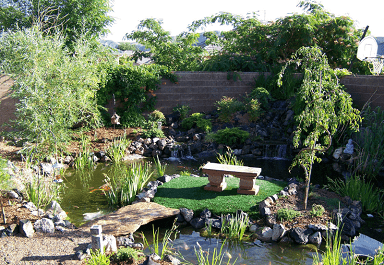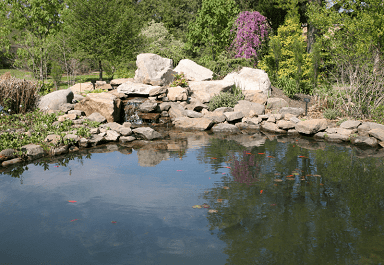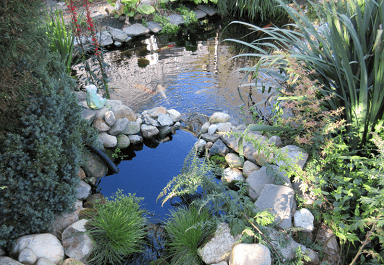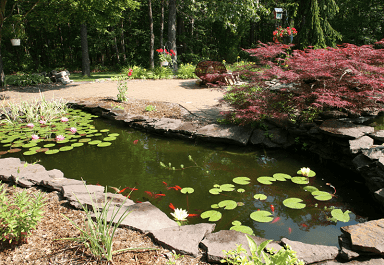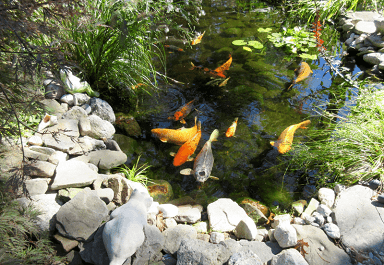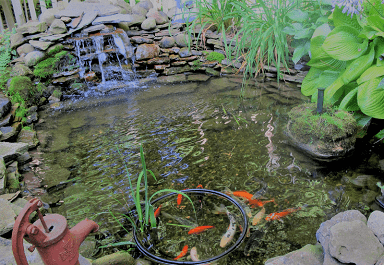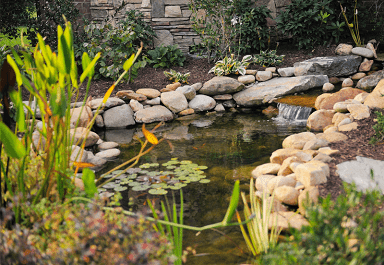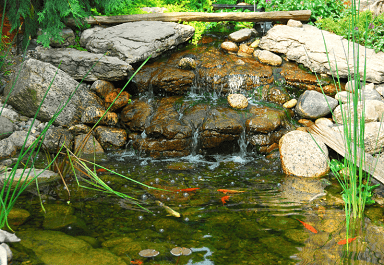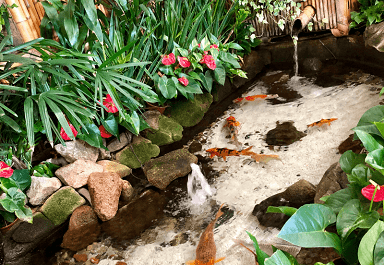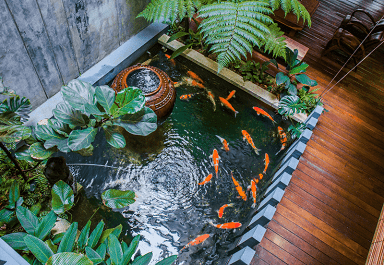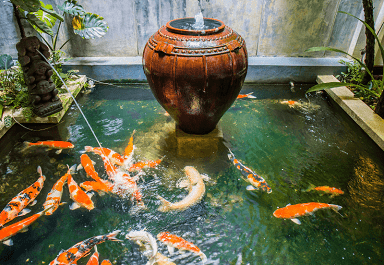Koi Ponds: Your Guide to Building and Maintaining
Pond Academy is reader-supported. Buying through links on our site may earn us an affiliate commission. As an Amazon Associate I earn from qualifying purchases.
A pond can add beauty, character, and style to your backyard. But throw in some koi, and you've got so much more!
Koi ponds have many benefits, including visual appeal, entertainment value, and the fact that Japanese koi make great, low-maintenance pets… just to name a few.
So, if you'd like to learn more about these unique ponds and get some insider tips and tricks to create your own koi pond paradise, then you're in the right place.
What Is A Koi Pond?
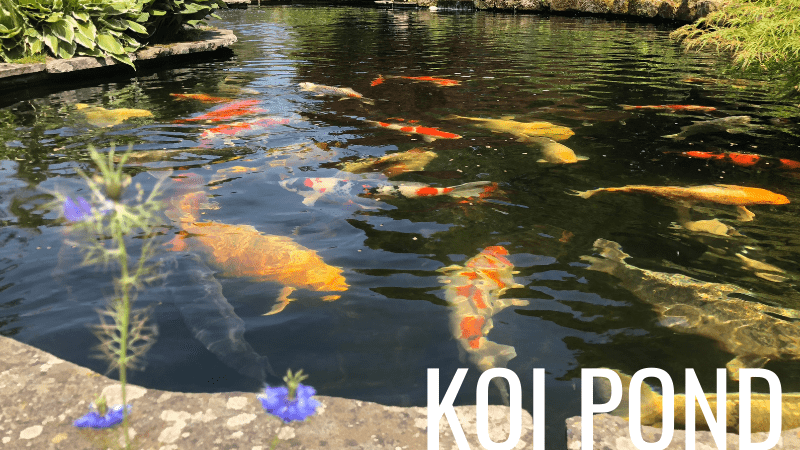
Koi ponds are, simply put, ponds that hold koi fish (colored Japanese carp that are kept as pets). Koi ponds can be purely decorative, as in most indoor or backyard koi ponds, and they can also be used for breeding purposes.
![]() Did you know...
Did you know...
Unofficially, the largest koi fish pond in the world is in an abandoned mall in Bangkok. The mall filled up with rainwater over the years creating a large mosquito problem. So, the community filled the water with thousands of koi fish to eat the mosquito larvae.
Koi ponds serve a slightly different purpose than your typical fish-free backyard water garden or pond. They both might be visually appealing and add character and style to your property's landscape, but koi ponds are more like a big fish tank or swimming pool for koi fish.
There are added concerns when introducing koi to a pond, like proper water aeration as the fish require oxygen for survival, extra water filtration as they produce more waste, and a properly sized pond pump that can handle the extra load.
With the proper setup (which we’ll get to in the next section) pond maintenance is really no worse than a backyard pond without fish. And you get the added beauty of watching these gorgeous colored fish swim through the water and even help get rid of mosquito larvae and eat algae.
Get Our Best Pond Tips Sent to Your Inbox for Free!
Join thousands of others and learn from our decades of pond building and maintenance experience! Your pond will thank you!
By subscribing you agree to receive emails from PondAcademy.com. We will always respect your privacy and you can unsubscribe at any time.
Requirements
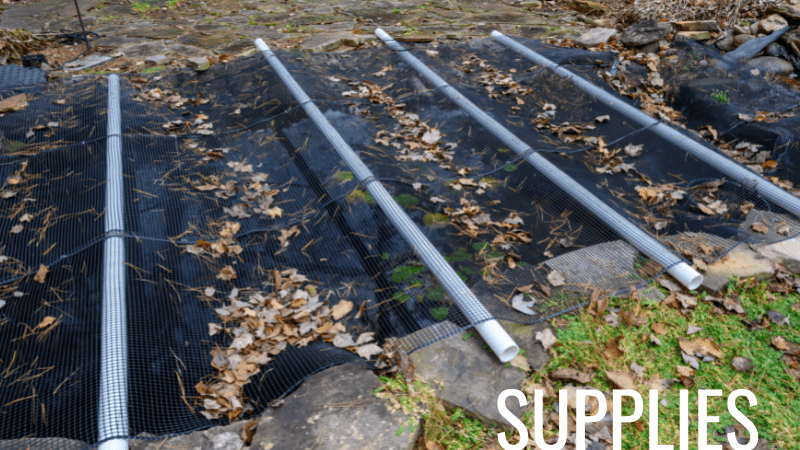
Whether you plan to build a pond or have an existing one, there are some equipment and supplies that are must-haves (and a few optional but helpful products too) if you plan on starting a koi pond.
![]() Tip
Tip
The products below need to be properly sized for your specific pond and its unique requirements. Use our best-in-class Pond Calculator to make sure you get the right size equipment for your pond!
Pond Liner
Your koi pond liner is like the foundation of your house, it needs to be durable and long-lasting to prevent any leaks. This is important not only for your pond's ecosystem but for the fish that live in it, as well.
Even if you can find a pond leak and stop it before it completely drains the water, a partial drain in a pond fully stocked with koi fish can leave them vulnerable and in an oxygen-depleted environment.
The best way to combat this is by choosing a high-quality and durable pond liner, whether that be an EPDM rubber liner, pre-form liner, etc. Check out our guide to the best pond liners on the market today and make sure you have the proper foundation laid for your koi pond.
Pond Filtration System
Pond filters are essential to keeping your pond water healthy and clean. And they are even more important when you have koi fish in your pond.
Koi are large fish that eat a lot of food. Not only does the leftover food add unwanted nutrients to your pond's water (which can lead to algae growth), but since they eat a lot, they well, poop quite a bit too. A pond filter will keep your water clean, help control the amount of waste that just adds to the sludge build-up on the bottom of your pond, and remove nutrients that fuel algae growth.
The best pond filter system if you have koi or other pond fish is going to consist of mechanical, biological, and chemical filter media, which is really no different than a pond without fish. However, the best koi pond filter system is one that’s properly sized for the pond it’s filtering. So, along with utilizing the three media types above, be sure your pond filter and pump size is adequate for your pond or water garden. Our pond filter calculator will help you get the perfect size filter for your pond.
Don't underestimate the importance of a quality koi pond filtration system! Keeping the environment your koi live in stable and clean will help extend the lifespan of koi and keep them happy.
Pond Pump
A quality pond pump is a must-have in a koi pond. Think of your ponds pump as the heart of your pond that powers everything from your filtration system, skimmer, to water features (like a waterfall or spitter) and aerators. It’s easy to see why utilizing a high-quality pond pump that is properly sized to your pond is extremely important.
And by properly sized, we mean one that will be able to turn your koi ponds water over at least once every hour. In other words, if you have a 500-gallon pond, you’ll want a pump rated at 500-gallons per hour (GPH) at the very minimum.
There are hundreds of different pond pumps on the market so to make it easy for you check out our reviews of the best pond pumps available today.
Koi Fish
Of course, if you're building a koi pond, you'll need to stock it with koi fish!
And nothing directly affects the health and longevity of your fish more than genetics. That's why it's extremely important to buy your fish from a high-quality and reputable breeder like Next Day Koi and not from local big-box pet stores like Petco and Pet Smart.
Aeration System
Pond aeration is important to maintain high levels of oxygen in the water for your koi fish. Typically, if you have good water flow in your pond through, for example, a fountain or waterfall, then you may already have adequate aeration. If not, or you have a lot of koi, it may be wise to invest in a separate pond aerator.
This will ensure that your pond water has adequate oxygen levels for your koi. Check out our pond aerator guide to find the right system for your pond.
Pond Skimmer (Optional)
Pond skimmers are great to have if your pond water is prone to collecting a lot of outside debris. For example, leaves, sticks, and any other debris that may blow or fall onto your pond's surface.
A pond skimmer will essentially suck in the debris that sits on top of the water. It’s important to trap and filter this debris before it sinks and decomposes on the bottom of your pond, which just adds to your pond sludge problem and creates other water issues, as well.
Just keep in mind, 90% of pond debris comes from trees, plants, and other external sources, so investing in a quality pond skimmer can save you money and troubles down the road. There are 5 skimmers that I highly recommend so be sure to check out our pond skimmer reviews.
Pond Netting (Optional)
A cheaper alternative to running a pond skimmer would be to place netting over your koi pond. This will effectively catch most debris before it even hits your ponds water. It’s also a proven and effective method for keeping predators, like heron, away from your koi fish.
The downside is you have a visible net covering your koi pond. Many find this to be unsightly and feel it takes away from the beauty of the pond.
If you feel like a net is the right option for you then check out our handy pond netting guide for more information.
Pond Heater (Optional)
If you live in a temperature zone where your koi pond has the potential of freezing over during winter, then you will definitely want to invest in a pond heater.
While koi will hibernate at the bottom of your pond over winter, if the surface of the water freezes over, then your koi ponds oxygen levels risk being depleted. A pond heater will simply keep a hole in the ice in the surface of your pond to allow for proper gas exchange.
If you think you’ll need a heater for your koi pond during the winter months then check out our definitive guide to Pond Heaters.
Pond Maintenance
There are certainly extra considerations to take when maintaining a koi pond versus a typical backyard pond without fish. However, once you have the right equipment in place, it’s really not any more difficult and the beauty that the fish bring to the pond makes it well worth it in our opinion.
Here are a few maintenance considerations you should be aware of before starting your own koi pond.
Water Filtration
Your koi pond will need an adequate water filtration system in place. And a properly sized pump to power the koi pond filtration system. As we discussed above, because koi produce a lot of waste, the most important thing is to have a filtration system that can keep up with your koi ponds' needs. You may have to clean your filters a little more often because of the added waste from the fish, but with that said, once you have the proper system in place, maintenance is a breeze.
Pond Water Temperature
If you live in colder temperature zones where the water freezes over in the winter months, then there will be some extra, albeit minimal, maintenance during this time. This will mostly consist of making sure a hole is kept on the surface of the ice. This can be easily handled with a pond de-icer, but as with all technology, it can sometimes fail, so you’ll just want to routinely check to make sure everything is working properly.
Predators
If you have animals like raccoons and heron in your area, you’ll have to take some extra precautions to make sure your koi are safe. Pond netting, electric fences, even a fake alligator head floating on the surface of the water can help protect pond fish from predators. Again, these deterrents are usually a one-time setup and you’re done, but you will have to make sure they are continually working and replace any worn deterrents as needed (pond nets, for example, can take a beating from bad weather conditions and aggressive predators).
As you can see, once you have the right equipment in place to cover these considerations, then there isn’t much more maintenance to do outside of regular pond maintenance.
Pond Plants
The best plants for a koi pond are ones that help oxygenate the water, provide valuable shade and shelter for your koi fish, and some plants can even be a supplemental food source for your little swimmers.
Aquatic plants are also how Mother Nature naturally filters out pollutants and improves water quality for your koi fish!
A couple of plants I recommend for koi ponds are:
Elodea
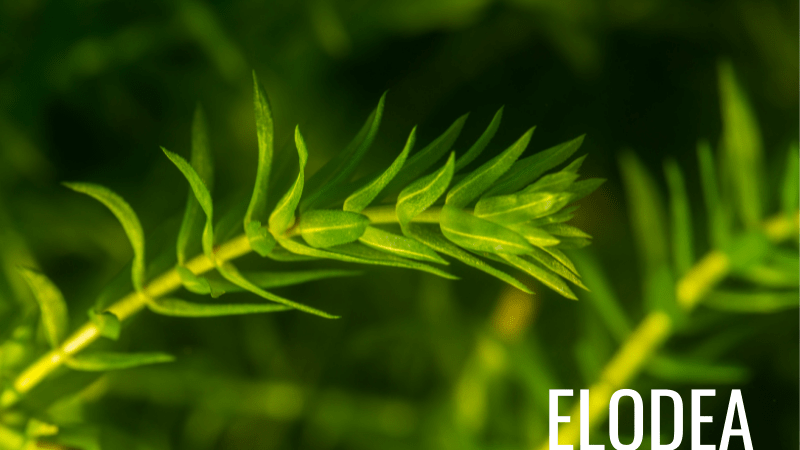
A popular oxygenating pond plant that provides cover and is a great spot for koi eggs to hatch. This submerged pond plant will typically stay green all year round (even in winter) and will help consume excess nutrients in the water, making these plants a great addition to any pond.
Ludwigia
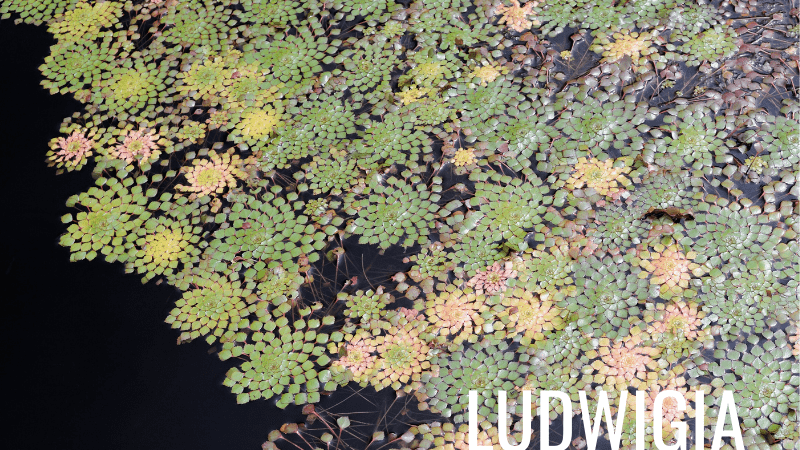
Ludwigia is an emergent pond plant that is an excellent oxygenator and provides valuable shelter for all kinds of fish. There are many species of ludwigia plants so you should be able to find a variety that works in your region.
Water lettuce
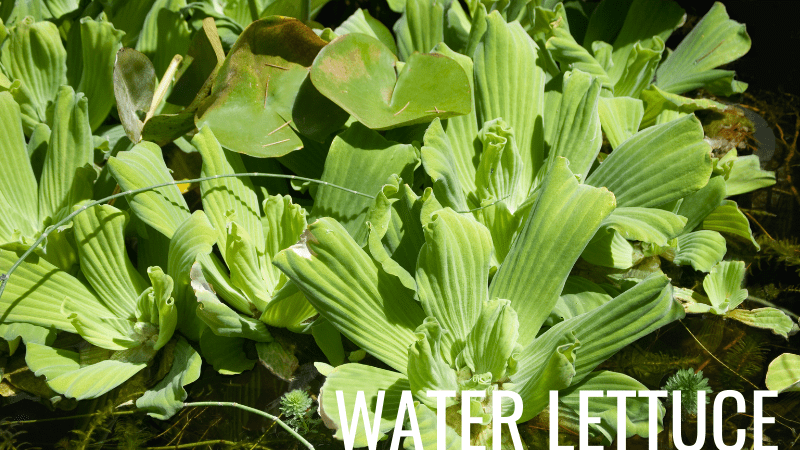
This is a free-floating aquatic plant that resembles lettuce or cabbage. It has roots dangling in the water column and floats on the surface of the water. Water lettuce provides shade from the hot sun and also a place for the fish to hide from predators.
Koi Pond Ideas & Designs
When it comes to designing and building your very own koi pond (or updating your current pond), your options are only limited by your imagination!
Here are some different koi pond ideas and designs to help get your creative juices flowing so you can create the koi pond of your dreams.
Click the photos below to enlarge (opens in new window).
Backyard Pond Ideas
Pond Waterfall Ideas
Small Pond Ideas
Indoor Pond Ideas
Check out our huge list of koi pond ideas with pictures for more ideas and inspiration.
![]() Tip
Tip
When designing your koi pond, remember that it should be at least 3 feet deep. And we would prefer deeper if possible. Especially if you live in a cold-weather climate and your pond freezes over. Koi need a spot for torpor (similar to hibernation) during the winter months and if your pond water completely freezes solid, they won’t survive. Check out our guide titled How Deep Should a Koi Pond Be? for more information and a few important considerations!
Cost to Build a Koi Pond
According to HomeAdvisor.com, the average cost to build a koi pond system is between $450 - $5,500. With that said, there are so many factors that it’s going to be tough to really dial that number in without more information.
Factors you’ll want to consider when planning a new koi pond include:
- The koi ponds design including size and depth
- The size of the pond liner, filtration system, and other products
- Cost of koi fish (Tip: Buy from a high-quality, reputable breeder like Next Day Koi to ensure you get the healthiest koi for the best price)
- Landscape features like rocks or stones, plants, and pond decorations
- If you plan to add a water feature like a waterfall, fountain, etc.
- Whether you plan on doing the work yourself or hiring out
Once you have a rough idea of the size of your pond, then you can start pricing materials and labor (if needed) to get a good estimate for the amount of money it will cost. You can use our Pond Calculator to help you find the right size liner, filter, and pump for your pond or water garden. And check out our guide titled How Much is a Koi Fish to get a breakdown of how much you can expect to spend on the different types of koi for your pond.
